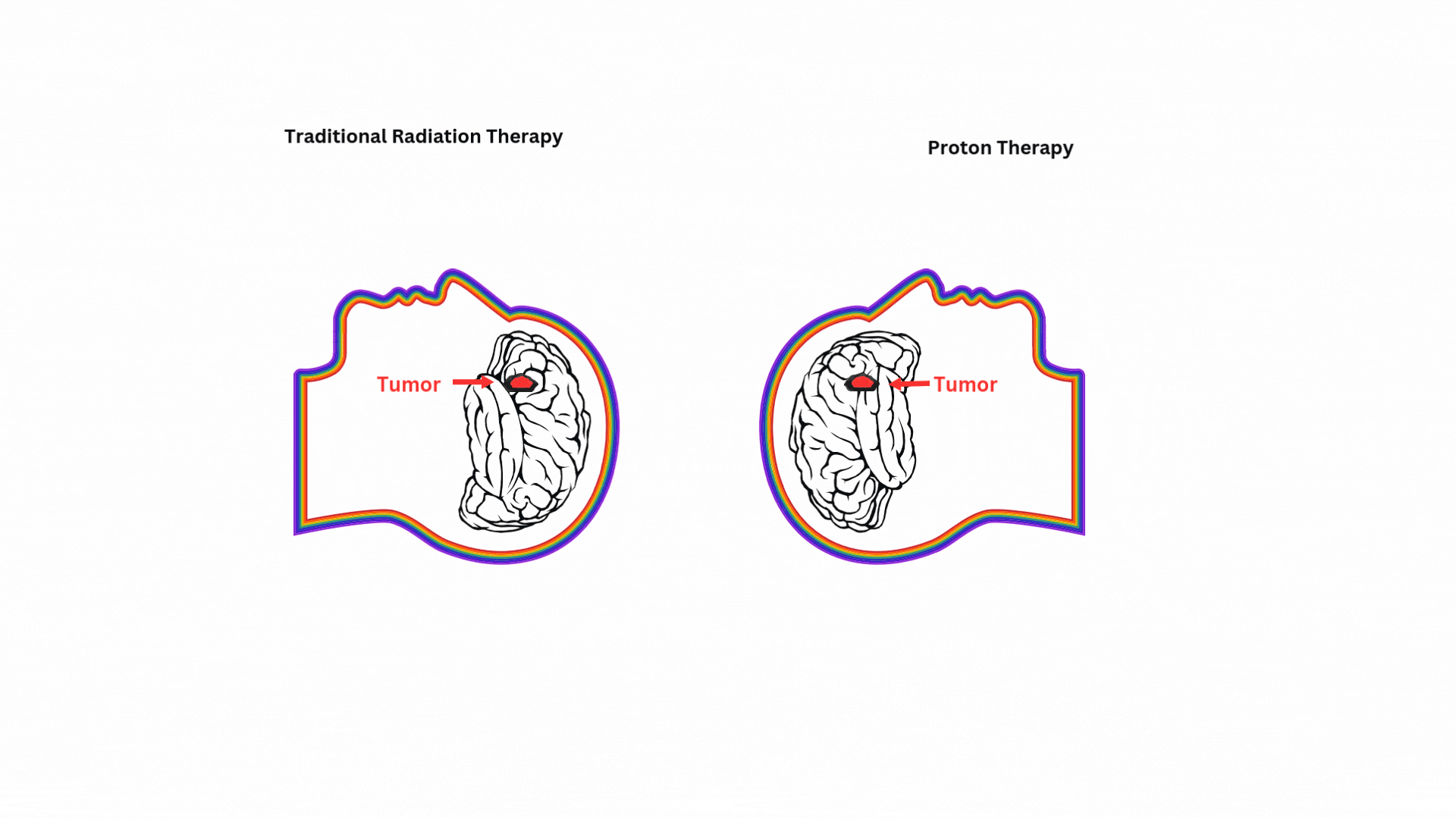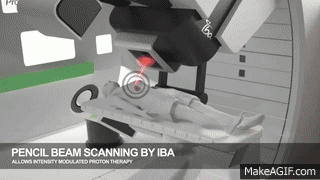Precision Cancer Treatment: The Power Of Protons
By Sunny Shroff
Proton Beam Therapy (PBT) is a type of radiation therapy that uses high-energy protons to target and destroy cancerous cells. Unlike traditional radiation therapy, which utilizes X-rays, PBT delivers a precise dose of radiation directly to the tumor, minimizing damage to surrounding healthy tissues. This precise targeting and reduced collateral damage contribute to fewer side effects and improved treatment outcomes for patients.
PBT involves using a cyclotron to accelerate protons to high speeds. These protons are then directed towards the tumor using sophisticated magnetic fields. The protons release their energy at a specific depth, known as the Bragg peak, which allows for highly targeted radiation delivery.
Working Principle of PBT
The working principle of PBT relies on the unique properties of protons. Unlike X-rays, which deposit energy along their path through tissue, protons release most of their energy at a specific point, known as the Bragg peak. The Bragg peak is a fundamental concept in proton therapy. It refers to the point at which protons release most of their energy, creating a localized dose of radiation that effectively targets the tumor. To visualize the Bragg peak, imagine a beam of protons entering the body. As the protons travel through tissue, they gradually lose energy. The Bragg peak occurs at the point where the protons have deposited most of their energy, resulting in a sharp increase in the radiation dose. Beyond this peak, the energy deposited by protons drops significantly, minimizing damage to tissues beyond the tumor.
What is a Cyclotron And Its uses in PBT
Imagine a giant magnet creating a circular path. Protons are injected into this path and are accelerated by an electric field. As they circle, they gain energy and are eventually extracted at high speeds, ready to be directed toward the tumor.
The cyclotron is a vital component of PBT, allowing for the generation of the high-energy proton beams necessary for targeted cancer treatment.
Precision In Radiation: From Conventional Therapy to Proton Beam
Conventional radiation therapy (RT) has been a foundational approach in cancer treatment, using high-energy X-rays or gamma rays to target and destroy cancer cells. There are various types of RT, each tailored to different needs: External Beam Radiation Therapy (EBRT) directs radiation from outside the body; Brachytherapy places radioactive material close to or within the tumor; Image-Guided Radiation Therapy (IGRT) employs imaging before each session to improve targeting; Intensity-Modulated Radiation Therapy (IMRT) adjusts beam intensity to match the tumor’s shape, and Intraoperative Radiation Therapy (IORT) applies radiation directly to the tumor site during surgery. Each method aims to concentrate the treatment on cancer cells while reducing exposure to nearby healthy tissues. However, the potential for side effects on surrounding tissues has driven the pursuit of even more precise options, leading to the development of Proton Beam Therapy (PBT) as a significant advancement in targeted cancer treatment.
Advantages Of PBT Over Traditional Radiation Therapy
Precise Targeting: PBT allows for precise delivery of radiation directly to the tumor, minimizing damage to surrounding healthy tissues.
Reduced Side Effects: By minimizing collateral damage to healthy tissues, PBT leads to fewer side effects and improved quality of life for patients.
Improved Treatment Outcomes: The precise targeting and reduced side effects of PBT can result in better tumor control and improved survival rates in some cases.
Less Damage to Critical Organs: PBT is particularly advantageous for treating cancers near critical organs, as it minimizes radiation exposure to these organs.
These advantages make PBT a compelling treatment option for patients seeking a more precise and less invasive approach to cancer therapy.
Applications Of PBT
Proton beam therapy has emerged as a valuable treatment option for a wide range of cancers, particularly those located near critical organs or sensitive structures.
Brain tumors: PBT minimizes damage to healthy brain tissue, reducing the risk of neurological complications.
Spinal cord tumors: PBT precisely targets the tumor, minimizing damage to the spinal cord, improving neurological function preservation.
Head and neck cancers: PBT minimizes damage to salivary glands, reducing the risk of xerostomia (dry mouth).
Prostate cancer: PBT minimizes damage to surrounding organs like the bladder and rectum, reducing the risk of urinary and bowel complications.
Lung Cancer: PBT targets lung tumors with precision, minimizing damage to surrounding healthy tissues like the heart and lungs.
Pediatric Cancers: Proton beam therapy is particularly beneficial for children with cancer as it can target tumors near critical organs and growing tissues, minimizing long-term side effects.
PBT's precise targeting minimizes collateral damage, making it particularly suitable for treating tumors in sensitive areas. Advanced technology allows for more effective treatment while minimizing potential side effects, improving the quality of life for patients.
PBT Projects in India and Other Countries
Proton beam therapy is becoming increasingly accessible worldwide, with numerous projects underway to establish dedicated PBT facilities. In India, several centers have emerged or are under development.
The Tata Memorial Centre in Mumbai houses one of the first PBT facilities in India. Other centers like the Apollo Proton Cancer Centre in Chennai and the HCG Cancer Centre in Bangalore are expanding access to this advanced therapy. Globally, countries like the United States, Canada, Japan, and Europe have established numerous PBT facilities, demonstrating the growing adoption of this technology in cancer treatment.
Limitations and Challenges of PBT
Despite its numerous advantages, Proton Beam Therapy faces certain limitations and challenges:
Cost: PBT facilities are expensive to build and operate, making treatment potentially more costly than traditional radiation therapy.
Availability: PBT facilities are not yet widely available, limiting access for patients in some regions.
Technical Complexity: PBT requires specialized equipment and highly skilled professionals, which can be a challenge in some settings.
Despite these challenges, ongoing research and development are addressing these limitations, paving the way for wider accessibility and affordability of PBT.
Dr. Laskar’s Insights on Proton Beam Therapy
With a discussion with Dr. Siddhartha Laskar, Deputy Director (Academics and Proton Therapy) at the Advanced Centre for Treatment Research & Education in Cancer (ACTREC) in Kharghar, Navi Mumbai, he shared valuable insights into Proton Beam Therapy (PBT) and its role in oncology. Dr. Laskar explained that the cost of a proton beam machine is approximately ₹400 crore, with vendors like IBA, Hitachi, and Varian leading in high-precision equipment. Installation of a single gantry can take 3 to 3.5 years, while three gantries may require up to 5.5 years. Notably, only 20-25% of radiation therapy patients are ideal candidates for PBT, with others effectively managed by LINAC systems. Therapy costs range from ₹5 lakhs for general patients to ₹25 lakhs for international patients. He also highlighted future advancements like carbon ion and helium machines, which can target multiple cancer cells more efficiently. The core mechanism of PBT, involving DNA double-strand breaks, disrupts cancer cell growth, and showcases the therapy's precision and potential in modern treatment approaches.
Future Outlook and Advancements in PBT
The future of proton beam therapy holds tremendous promise. Researchers are actively exploring innovations and advancements to further improve the effectiveness and accessibility of this treatment modality.
Some key areas of focus include
Development of more compact and affordable cyclotrons to make PBT more accessible. Advancements in imaging and tracking technologies for even more precise radiation delivery. Clinical trials to investigate the use of PBT for a wider range of cancers. Integration of PBT with other cancer therapies such as immunotherapy and chemotherapy for enhanced treatment outcomes. As research progresses, PBT is poised to become a more widely available and even more effective treatment option for cancer patients.
Author :
Sunny Shroff
Sunny Shroff is a passionate Bioengineering professional with a Master's in Marketing Management, specializing in driving innovation in the medical devices industry. With extensive experience spanning clinical applications, technical expertise, and a robust skill set in Marketing and Sales Management, Relationship Management, and Communication, Sunny brings a unique blend of expertise to every project.





